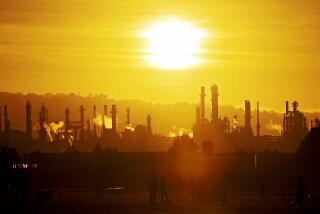Court skeptical of EPA regulations
WASHINGTON — The Supreme Court, in a hearing Monday, sounded ready to reject a set of disputed permitting rules designed by the Obama administration to restrict carbon emissions from plants and factories.
But a majority of justices also agreed that the Environmental Protection Agency has broad authority to reduce greenhouse gases coming from cars, trucks and power plants.
The probable split outcome was reflected in the justices’ questions and comments during oral arguments, suggesting their final decision later this year could yield a setback for the EPA rules, but not a far-reaching defeat for the agency’s climate-change policy.
The case was the first before the court to directly challenge Obama’s climate-change policy.
Last year, energy industry advocates and Republican state attorneys general argued that the EPA went beyond its legal authority by using the Clean Air Act to regulate greenhouse gases and drafting permitting rules to limit carbon emissions from newly constructed plants, factories and other buildings.
Monday’s argument focused narrowly on the permitting rules, which critics said was an inappropriate expansion of the agency’s authority.
At one point, Justice Anthony M. Kennedy, who probably holds the key vote, said he agreed with industry advocates that the EPA may have gone beyond the law in requiring the permits.
Under the Clean Air Act, new facilities that are expected to emit a certain amount of harmful pollutants must obtain a permit in advance.
When the EPA added carbon dioxide to the pollutants that they regulate, they decided to raise the established limit without congressional approval. That’s because carbon dioxide is so plentiful that a literal interpretation of the Clean Air Act could have extended the new rules to thousands of houses, office buildings and shopping malls.
The agency preferred to focus the rules on large industrial facilities. But by raising the limit, the EPA left itself open to attack from industry lawyers, who accused it of rewriting the law to support its regulations.
Kennedy said the critics had a good point.
“I couldn’t find a single precedent that strongly supports your position,” he told U.S. Solicitor Gen. Donald Verrilli Jr., who defended the EPA rules.
If Kennedy joins with his four more conservative colleagues, they would have a majority to strike down the permitting rules.
But at the same time, Kennedy gave environmentalists cause for cheer. He said that even if permitting rules were voided, EPA would have ample authority to regulate greenhouse gases in other ways. One option calls for enforcing national standards for carbon emissions.
Kennedy joined the 5-4 decision in 2007 that said the EPA had the authority to regulate greenhouse gases as air pollutants under the Clear Air Act, and he gave no hint of backing away from that ruling.
But Chief Justice John G. Roberts Jr. questioned whether the Clean Air Act should be used to regulate greenhouse gases, which he noted are a global problem, in contrast to car emissions, which have a local effect.
“Everybody knows there’s smog in Los Angeles versus Montana,” Roberts said. For that reason, he said, regulators in Southern California can impose pollution controls that would be unwarranted in Montana.
Industry lawyers claimed the permitting rules, if upheld, would “result in a program that would be unrecognizable to the Congress that enacted it,” Washington lawyer Peter Keisler told the court.
But environmentalists and government lawyers said the critics have greatly exaggerated the reach of the permitting program. They said the EPA has targeted major new polluters, such as power plants.
The court’s four Democratic appointees — Justices Elena Kagan, Sonia Sotomayor, Ruth Bader Ginsburg and Stephen G. Breyer — sharply questioned the lawyer representing the major utilities and energy producers.
Kagan said the EPA has focused its permitting rules on the major polluters, even if it had to “fudge the numbers” to do it.
The Republican appointees led by Justices Antonin Scalia and Samuel A. Alito Jr. aimed their questions at the administration’s lawyer. Scalia said he did not see how the EPA could revise the words of the law to fit its permitting rules.
The justices will hand down a decision in the case by late June.
Still pending from December is another Clear Air Act case that will determine whether the EPA can enforce new limits on coal-fired power plants in the Midwest that send pollution drifting toward the East.







